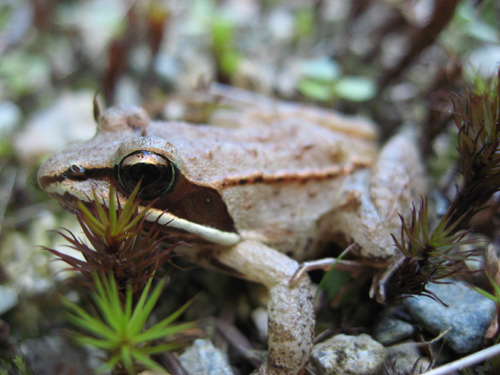The Wood Frog is in decline in Connecticut. Its skin is pinkish to brown and it has a dark brown mask across each eye. Its belly is white. Wood frogs can be 1 1/2 to 3 inches long.
Wood frogs range through the northern US, through Canada and in Alaska. They are found north of the Artic Circle. They live throughout Connecticut. Wood frogs in the east live in moist forests. Tadpoles live in the water until they reach maturity. Wood frogs are active during the warm season and hibernate for the winter under leaf litter, rocks and logs in the forest. Wood frogs can survive being frozen solid for several months and don't bother digging below the frost line. They overwinter in burrows just a few inches deep. They are active during the daytime.
Adult wood frogs' diet includes insects, slugs, snails and earthworms. They hunt bugs by shooting out their sticky tongue to trap an insect and draw it back into their mouth. Immature wood frogs, tadpoles, feed on plant matter but will eat frog eggs and smaller tadpoles too.
Wood frogs are very cold tolerant and sometimes emerge from hibernation in Connecticut as early as February, although March emergence is more common. Wood frogs may gather at mating pools while ice is still present. Wood frog eggs can survive short periods of being frozen. Mating season is usually in March and April. Wood frogs use temporary vernal pools for mating and breeding and are dependent on them for species survival. Male wood frogs sing mating calls to attract a mate. A male grabs the female around her chest with his front legs and clings until she lays her eggs in the water. He deposits sperm on top of them. The female frogs produce up to 2,000 eggs in a gelatinous mass. The mass is attached to plants below the water surface. In about 3 weeks the eggs hatch into tadpoles. It can take 2 to 4 months for the tadpoles to absorb their tails, grow legs and develop lungs and hop off to begin terrestial life on the forest floor. Tadpoles live only in the water.
Wood frogs are solitary, except when they congregate in breeding waters in the spring. The mating calls of the males sound like short quacks. Click on the wood frog call link under the photo for an example.
Frogs produce their calls by inflating part of their mouth lining under their throat with air through an opening in the bottom of their mouths. They then close off their mouths and nostrils and pump air between their lungs and this vocal sac over their vocal chords. The vocal sac of a calling frog is clearly visible as a bubble under his throat.
Neat Facts
Wood frogs are the only frog species that can live north of the Arctic Circle. They reach about 69 degrees latitude, which is also the northern limit to where northern spruce forests can grow.
Most animals cannot survive being frozen solid. If cells freeze solid, jagged ice crystals rupture cell membranes and cause tissue damage and death. The ability to survive freezing displayed by wood frogs is the result of high concentrations of the sugar glucose the frogs can produce when temperatures drop. High levels of glucose in the cells prevent the actual cells from freezing. Ice forms around organs and cells, but not within them. In the spring, wood frogs thaw from the inside outwards. Wood frogs are one of the frog species in which this phenomenon is most often studied.
